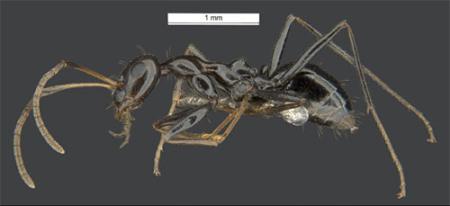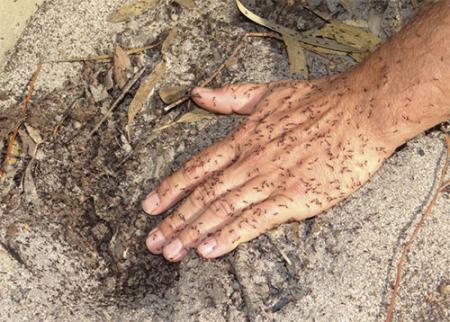Browsing ant (Lepisiota frauenfeldi) is a small exotic ant that is currently under eradication in the Northern Territory (NT). It is a serious threat to our environment.
Detection in the Northern Territory
Browsing ant was first detected in the NT at Darwin’s seaport in June 2015. A total of 23 infested premises have been identified since 2015. The ant has been eradicated from 22 of these premises.
The remaining infested site is near Kakadu National Park. It was detected in September 2020 and was directly linked to one of the sites in Darwin.
Response program
The Northern Territory Department of Agriculture and Fisheries (DAF) leads the response to this outbreak. This ant is a nationally significant pest and is managed under the National Environmental Biosecurity Response Agreement (NEBRA). Costs are shared by the Australian, state and territory governments.
A response plan that aims to eradicate the ant is in place. The plan includes:
- surveillance and monitoring
- treatment to eradicate the ant at the remaining infested site
- movement restrictions on potential host material at high-risk sites
- monitoring after treatment of infested premises for at least 2 years.
Treatment at all sites in Darwin has been completed. Treatment is continuing at a site near Kakadu National Park. Surveillance has confirmed that browsing ant has not spread into surrounding areas.
NT DAF has undertaken surveillance across the NT, with support from Indigenous ranger groups at remote sites.
See more at Exotic ants (NT government).
Your obligations
You can help contain this ant by reporting any suspect sightings.
Avoid accidently moving browsing ants. Take care not to move any ants on goods, vehicles, clothes, plant material or soil.
Report sightings
If you suspect you’ve seen browsing ants, report them as soon as possible, even if you’re not sure.
To report suspect ants from anywhere in Australia you can call the Exotic Plant Pest Hotline on 1800 084 881.
For signs of exotic pests and diseases in imported goods, sea containers or parcels, call See. Secure. Report on 1800 798 636 or use the online form.
Follow the rules
Keep exotic dangerous pests and diseases out of Australia. Never ignore our strict biosecurity rules.
Imports may need to be treated and certified. Before you import, check our Biosecurity Import Conditions (BICON) system.
Movement restrictions
Movement restrictions are in place at infested sites. You must adhere to them. They ensure the ant is not moved out of the area or interstate.
Check the latest restrictions in the Northern Territory.
About the pest
Browsing ant is found in the Mediterranean, Southern Europe, Western Asia and North Africa. The ant thrives in Mediterranean and tropical climates. This means it is suited to Australian conditions.
What to look for
Browsing ants are slender and 3-4mm in length. They are a consistent shiny dark brown colour with long antennae and long legs. When disturbed, they run about in a haphazard manner.
Browsing ant can live on the ground, in leaf litter, trees and infrastructure such as electrical boxes.
How it spreads
Ants can hitchhike on goods and vehicles. They can move with shipping containers and cargo. They can also hide in soil, mulch, fertiliser and plant material.


Impacts
Browsing ant is an environmental pest. It forms multi-queened super-colonies and monopolises food resources. It can quickly reach large numbers. The ants put our native species at risk by killing them for food and competing for resources.
Browsing ant also farms and protects scale insects which can eventually kill the plants it lives on. This means it can potentially impact agriculture and horticulture.
Browsing ant is not harmful to people or pets.
Past detections that have been eradicated
Browsing ant has also been detected and eradicated several times in Western Australia including:
- 2013 – Perth Airport (first detection in Australia). Area freedom declared in 2016.
- 2014 – Belmont, Perth. Area freedom declared in 2017.
- 2017 – Welshpool and Kewdale, Perth. Area freedom declared in 2024.
- 2018 – RAAF Airbase in Bullsbrook, Perth. Area freedom declared in 2024.
- 2019 and 2020 – Welshpool, Fremantle Port, Bayswater and East Rockingham in Perth. Area freedom declared in 2024.
Eradication efforts in WA included over 6,000 inspections at more than 2,700 premises, and the support of specialist odour detection dogs from the Queensland National Fire Ant Eradication Program.
Browsing ant was also detected at the Port of Brisbane in Queensland in 2019 and was subject to an emergency response. Treatment was completed in March 2020, and verification of area freedom is underway.